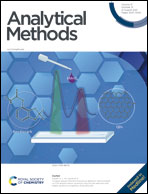Ultrasensitive and turn-on homogeneous Hg2+ sensing based on a target-triggered isothermal cycling reaction and dsDNA-templated copper nanoparticles†
Abstract
In this work, an ultrasensitive and turn-on sensor for homogeneous Hg2+ detection has been constructed based on a target-triggered isothermal cycling reaction and rapid label-free signal output with dsDNA-templated copper nanoparticles (CuNPs). As the key component of the sensor, a hairpin DNA without any labels was designed to contain different functional sequence segments and to resist digestion by exonuclease due to the protruding 3′-terminus. In the presence of Hg2+, the formation of a T–Hg2+–T structure turned the protruding 3′-terminus of the hairpin DNA to a blunt end that could be efficiently digested by Exo III, accompanied by Hg2+ release, followed by another digestion cycle. Hence, the Hg2+-triggered isothermal cycling reaction accumulated numerous dsDNA templates that facilitated fluorescent CuNP generation and finally output an amplified signal used to identify the target. This protocol is capable of Hg2+ sensing in a concentration range of 5 orders of magnitude with a detection limit down to 3.9 pM. The as-constructed sensor also revealed high selectivity, as well as satisfactory results in recovery experiments of Hg2+ detection in real water samples.



 Please wait while we load your content...
Please wait while we load your content...